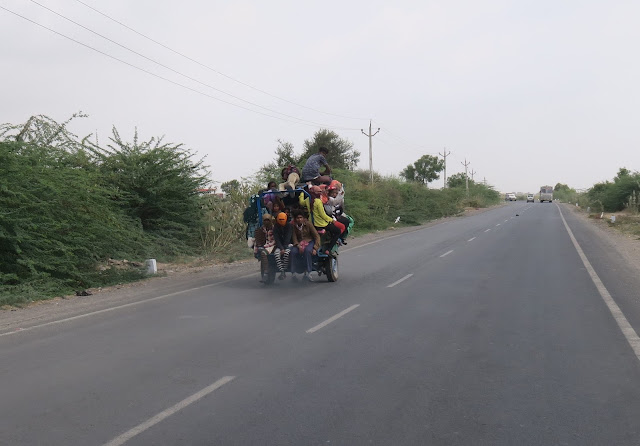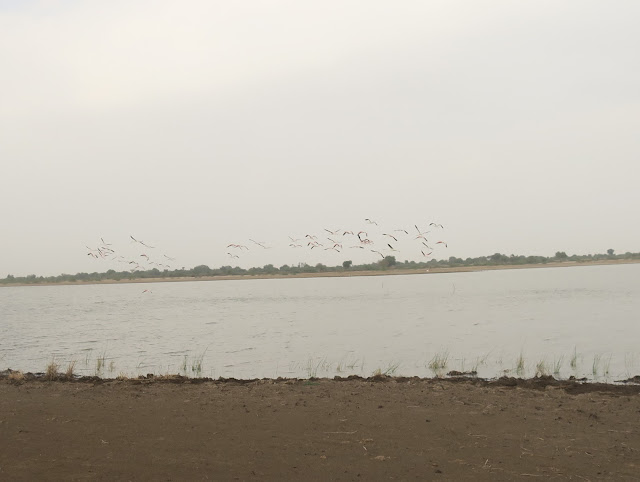Gujarat: The What, Where, When and Who
 |
| India |
 |
| Gujarat |
This post covers day 6 of a 14-day journey around Gujarat, following our circuit of Rajasthan last year. Smaller than Rajasthan, Gujarat is about the size of the Island of Great Britain and has much the same population.
5,000 years ago, Gujarat was a centre of the Indus Valley civilization and subsequently played its part in most of the major north Indian empires. When Islamic invaders reached northern India in the 9th century Gujarat held out until 1300 when it became part of the Delhi Sultanate.
 |
| Today we drive from Bajana to Velavadar and the Blackbuck National Park |
An independent Muslim sultan seized power in 1391and Gujarat maintained its independence until becoming part of the Mughal Empire in the 16th century and later the British Empire, though local rulers of a patchwork of Princely States retained considerable autonomy. At independence in 1947 Gujarat was part of the State of Bombay, becoming a state in its own right in 1960.
With a long coast line facing the Arabian sea, Gujaratis have been seafarers and international traders for millennia.
Gujarat is the home state of both Mahatma Gandhi and the current Indian Prime Minister Narendra Modi.
-o0o0o-
A Village Festival and a Park Teeming with Wildlife
Bajana to Velavadar
After a breakfast of omelette, stuffed parathas and fruit we set off on the 3½hr journey south from Bajana to the Blackbuck Park. We drove through agricultural land growing wheat, cotton, sesame and cumin among other crops. As usual cattle, sheep and goats were being herded along the highway while yet more cattle wandered at will.
 |
| This time it's cattle causing the holdup |
A Village Festival
After 80mins we stopped at a village – I am unsure of the name – where there was a market and celebration, something to do with Lord Shiva, Vijay told us. Makeshift stalls were laid out along the side of the road…
 |
| Stalls alongside the road, Gujarat village market |
….in parked vehicles and on any available piece of ground.
 |
| Stalls in tuk-tuks and spreading up the alleys, Village market |
As every English shepherd once had his crook, every Indian herder of beasts has his stick. Like the crook they are not for hitting, but for pointing, waving and generally being an extension of the herder’s arm. I would have thought that one would have seen out a lifetime’s herding, but business was brisk at the pole store.
 |
| Herders' sticks in the market |
Being a holiday, there were entertainments for children. The bouncy castle looked a little underinflated and the round-about as minimal as they come, and both would have looked better without the litter - in India there is always litter – but for the village’s smallest citizens, I am sure they were objects of wonder.
 |
| Round-about and bouncy castle (not that it is, strictly speaking, a castle) |
This was a religious holiday, so we joined the stream of people making their way to and from the small temple.
 |
| Lynne and Vijay make their way to the temple |
We had plenty of stares, foreigners are rare round here, but inquisitive rather than threatening. At the temple Vijay said he would watch our shoes while we had a look, though elsewhere we just left them unwatched with all the others. Ours looked bigger, a little better quality but just as dusty as the villagers’ so we wondered why but said nothing.It was a small Hanuman shrine, with a simple idol and clouds of jasmine scented smoke; an attendant offered Lynne a tilak as we left. Vijay then asked us to watch his shoes while he paid his respects. They looked expensive and far cleaner than ours, but then he was always crisply dressed, regardless of the heat or dust.
 |
| The village temple and a collection of shoes |
The Blackbuck Resort, Valavadar
After another 90mins driving arable land gave way to flat scrub, arid but less salty than the Little Rann of Kutch.
 |
| Arable farms give way to scrubby grassland as we approach Velavadar |
We soon reached our accommodation, ominously appearing on our itinerary as the Blackbug Resort but actually the Blackbuck Resort. It consisted of large, comfortable well-separated traditional bungalows forming a loose semi-circle in the dry grass.
 |
| Our bungalow, Blackbuck Resort, Velavadar |
We dumped our luggage and wandered back to the restaurant, a very smart affair with crisp tablecloths and quality china. Being on full board we ate a set meal, the smartly dressed waiter bringing a succession of small dishes, carefully explaining each. Peanut kofta, a variation on waldorf salad, murgh makhani, a vegetable curry based on bottle gourd, paneer with spinach, kulcha and pappads were all well-cooked, well-spiced and beautifully presented. A beer would have been a perfect accompaniment, but unfortunately Gujarat is dry (though not completely - I had a tourists’ liquor licence which allowed us a nightcap in the privacy of our room).
Returning to our bungalow during the midday heat, we sat on our large veranda facing the open savanna. Later we would visit the Blackbuck Nature Reserve, but the antelopes are common throughout the region and several visited as we relaxed in the shade.
 |
| A male blackbuck keeping a wary eye on us, Blackbuck resort, Velavadar |
The Blackbuck National Park
A jeep arrived to take us the short distance to the National Park near the village of Velavadar.
In the tiger sanctuaries of Nagarhole and Ranthambhore (4 ‘safaris’ 0 tigers), where you can go is dictated by the terrain, in the Little Rann of Kutch we roamed freely but the savanna of the Blackbuck Park is neatly divided into rectangular sections by well-made, though unpaved, roadways.
We sat in the back of the jeep with Vijay, who enjoys these parks and has some knowledge of local birds, while in the front was a park ranger and a driver.
 |
| The park ranger with a remarkable talent, Blackbuck National Park |
I had paid the expensive camera fee and hoped for some good pictures, Lynne’s phone camera was free but I doubted it would be much use in these surroundings. How little I know! Most of the pictures that follow were taken on Lynne’s phone by the ranger. We all had binoculars and he had perfected the technique of looking through one ‘nocular’ while holding the phone to the other and taking pictures. This would be easy for four-armed Lord Shiva, but the friendly ranger appeared to be an ordinary human.
 |
| A male blackbuck and part of his harem, Blackbuck National Park |
Blackbuck were not difficult to find, the grassland on both sides of the road teemed with them and deciding which group to photograph was the biggest problem.
 |
| Juvenile blackbucks, Blackbuck National Park |
Nilgai (also known as blue bulls), the other common antelope in this part of India, were present in slightly smaller numbers. Much stockier and less graceful than the blackbuck the males have stumpy little horns. Fully mature males look bull-like and really are blue, the nilgai below are juvenile males.
 |
| Nilgai, Blackbuck National Park |
He also photographed birds. We saw both common and demoiselle cranes, they are similar, but we saw demoiselle cranes in Mongolia in 2007 and comparing photographs I think those below are common cranes.
 |
| Common Cranes, Blackbuck National Park |
Even more impressively he captured a series of sharp images of a montagu’s harrier in flight…
 |
| Montagu's harrier, Blackbuck National Park |
…while I was still fiddling with the settings on my camera.
 |
| Montagu's harrier, Blackbuck National Park |
The full bird list included snake eagle, short tailed lark, crested lark (flying up like a cloud from the roadway as we drove along), partridge, flamingo, spoonbill, bay-backed shrike, green bee-eater (brightly coloured little birds, I managed a reasonable photograph in Sri Lanka, laggar falcon, white-tailed bulbul and last, but not least, the very common red-wattled lapwing – my sole contribution to these photographs in the park.
 |
| Red-wattled lapwings, Blackbuck National Park |
It was not just birds and antelopes, we may have failed to see any of the resident Indian wolves, but we did see a wild dog, and caught a fleeting glimpse of a hyena, though it ducked down into the long grass before even the ranger could raise a camera. A wild pig was more cooperative…
 |
| Wild pig, Blackbuck National Park |
….and yet another male blackbuck crossed the path in front of us as we headed for the exit.
 |
| A blackbuck bids us farewell as we head for the exit |
Back at the Blackbuck Resort dinner was as good as the lunch, the centrepiece being a fine vegetarian thali with a mixed salad.
 |
| Vegetarian thali at the Blackbuck Resort |
Part 1: Ahmedabad (1) Liquor Licences, Mosques and Tombs
Part 2: Ahmedabad (2) A Stepwell, Gandhi and a Thali
Part 3: Meeting the Locals
Part 4: Siddhpur, Patan and Modhera
Part 5: Salt and Wild Asses in the Little Rann of Kutch
Part 6: Blackbuck National Park, Velavadar
Part 7: Bhavnagar
Part 8: Palitana and the Temples on Shatrunjaya Hill
Part 9: A Lion Hunt and a Visit to Junagadh
Part 10: Gondal
Part 11: Gondal to Bhuj
Part 12: Bhuj
Part 13: To the Great Rann of Kutch, Craft Villages and a Salt Desert
Part 14: Going to School and Other Entertainments in the Great Rann of Kutch





































